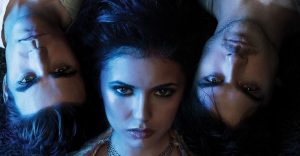Cape Fear: How The Simpsons Parody Compares To The Scorsese Movie

How does The Simpsons parody of Cape Fear compare to the 1991 Scorsese thriller? Thirty years have past since The Simpsons’ first episode and the show is a genuine institution in television comedy and the Fox show has spoofed plenty of other shows and movies over that period. Later seasons of the family sitcom may have fallen out of favor with fans and critics but at its peak, the series was an unprecedented force in television history. Smart, satirical, surreal, sentimental, and always very funny, for its first ten seasons or so The Simpsons was an unstoppable comedic juggernaut.
Though The Simpsons is one of the most influential TV shows of all time, Martin Scorsese is on another level in cinematic terms when it comes to artistic impact. The Taxi Driver director’s oeuvre is as masterfully composed and has proved just as influential as the best of the Springfield family’s on-screen outings. And as if to invite the comparison, The Simpsons honored Scorsese with an entire episode that was a shot-for-shot parody of his 1991 psychological thriller, Cape Fear.
Of all Scorsese films for The Simpsons to parody, Cape Fear is a strange choice, since it’s something of an anomaly in the iconic filmmaker’s canon. For one thing, it’s a remake of the tense, less gruesome sixties original of the same name starring Robert Mitchum. For another, this sordid story of Nick Nolte’s morally grey lawyer and Robert De Niro’s madman who turns his life into hell is an atypically fun one for the director. Yes, all of Scorsese’s films have moments of levity (except Silence), and with its murders, graphic assaults, and constant suspense the R-rated Cape Fear remake isn’t packed with laughs, but where most of Scorsese’s films tackle heavy themes of religion, self, meaning, and morality, Cape Fear is mostly just a nasty, great little thriller with a slasher film-influenced denouement. So with The Simpsons picking a trashier, flashier Scorsese outing to roast, how do the two stack up when compared to each other?
The Prison Exit

First and foremost, the Simpsons episode ‘Cape Feare’ is a labor of love. There are jokes aplenty, with the show’s rapid-fire rate of comedy comparable to Airplane and the Marx Brothers at their best. But many of the episode’s homages aren’t even comedic, but rather just perfect recreations of the source material. The prison exit is one of those moments that’s less of a parody and more of a riff on the original. In a rarity for The Simpsons, there’s no gag inserted here, just a recreation that perfectly mirrors the original (like Gus Van Sant’s Psycho, except not terrible). Sideshow Bob’s scowling face lines up with De Niro’s, both frown straight down the lens of the camera almost-but-not-quite breaking the fourth wall, and then a hard cut to the next scene. It’s an impressive achievement and one that sets up the episode’s spoof perfectly.
The Cigar Gag

And no more than a few seconds later, the jokes kick in. There’s never a long wait for gags in pre-season 12 Simpsons and this one doesn’t disappoint as we see the episode perfectly recreate another shot from the film where De Niro is tormenting his fellow theater patrons by cackling menacingly and smoking a cigar, sending obnoxious plumes of noxious smoke throughout the cramped auditorium. The diminutive De Niro makes the original scene ooze pure menace, but of course, The Simpsons iteration of the shot puts a comic spin on things. Sideshow Bob reclines with his cigar and annoys Marge, Lisa, and Bart who are seated behind him. Marge notes how obnoxious this mystery man is and there’s a genius cut to Homer, who agrees even though naturally, he’s also disturbing fellow cinemagoers with an even bigger cigar (and, this being Golden Age Simpsons, it’s not just a typical stogie but instead a giant one with Knoxville World Fair ’83 inexplicably emblazoned on its side).
The Movie Theatre Scene

Immediately after the reveal that Homer is as much of (if not more of) an annoyance as Bob, the episode launches into the next riff on Cape Fear’s once-unsettling scene. In Scorsese’s version, De Niro continues cackling maniacally despite the protestations of Nolte’s nebbish family man lawyer and, sufficiently annoyed and unnerved, Nolte and his brood soon depart the cinema in a moment of intimidation worthy of Goodfellas‘ murderous Jimmy Conway. But American everyman Homer Simpson isn’t so easily deterred from his viewing of ‘Ernest Goes Somewhere Cheap’, and leans over to tell Bob to quit laughing so loud only for the sight of the titular hero getting his head stuck in a toilet to prompt Homer to laugh even louder than Bob, clap him on the back, and return the effete villain to his usual pretentious self as Bob gasps “Oh, now really that is too much.”
The Workout Routine

There’s another superb side-by-side recreation in the workout scenes included in both Cape Fear and The Simpsons‘ ‘Cape Feare’, with both Scorsese’s thriller and the animated homage featuring montages of their antagonists pumping out pull-ups. Like the prison exit mentioned earlier, the shots are recreated flawlessly in the cartoon parody, but of course in The Simpsons‘ version of events Sideshow Bob’s back is adorned not with the massive, ominous cross tattoo on De Niro’s, but with a colorful tattoo of Bart’s severed head sitting on a skateboard and yelling “Ouch, man!”. It may seem pretty violent and pointed but bear in mind Bob’s explanation of his “Die, Bart, Die” chest piece in the preceding scene, which he notes simply means “The, Bart, The” in German to the satisfaction of the jury. You really can charm anyone when you’re voiced by Frasier‘s Kelsey Grammer.
The Toy Tripwires

The Simpsons episode also takes care to recreate more minor moments from the film, small touches which do an incredible job of honoring the original (while ironically ensuring no one will ever be able to take it seriously upon a rewatch). In one such example, both feature their paranoid protagonists using toys to tie off tripwires that will warn them of intruders. Of course in ‘Cape Feare’, the toy is a Krusty the Clown doll (possibly the previously possessed Krusty of ‘Clown Without Pity’), and the over-prepared Chief Wiggum has tied it to every door handle, cabinet, wall, table, and piece of furniture in the entire house, creating a spider’s web of knotted tripwires crossing over each other.
How The Simpsons’ Cape Feare Story Compares To Cape Fear

Due to the show’s unusual formula, TheSimpsons‘ Cape Fear parody isn’t an exact remake. But for a PG-rated family-friendly comedy the show does an incredible job of hewing close to the source material. The original film’s killer is after Nolte’s lawyer for getting him thrown in prison, the same reason Bob wants revenge on Bart. Both are driven mad in their quest for vengeance, and both go to extremes in search of it. Both track their prey to a busy parade (although only Bob gets trampled by said entire parade in an ingenious homage to the Naked Gun series). Both strap themselves to the underside of their would-be victim’s car (although only Bob gets dragged through a field of cacti for his troubles). Both are almost driven away by hired goons (although De Niro beats them senseless after they attack him, whereas the P.I Homer hires just whinily begs Bob to leave them alone). It’s a near-perfect match where most of the content cut is either too dark (like De Niro’s violent assaults) or wouldn’t fit the episode’s limited runtime. After all, the writers needed space for Bob to stand on eighteen rakes in quick succession.
The episode’s plot is less complex, although only marginally so, and both do end with very similar boat-bound last-ditch attempts to kill the hero. But (almost) no one dies on The Simpsons, so instead of a fight to the death, Bart appeals to Bob’s showmanship and ego by getting him to perform an entire musical to distract… himself. This was the last Simpsons episode that the show’s original writing team worked on together and it shows, with the finished result being a true gem. But the departing troupe didn’t let themselves get mired into sentimentality, instead opting to include increasingly zany and bizarre touches as they were aware they couldn’t be fired or admonished once they were already leaving. The result can stand toe-to-toe with the likes of ‘Homer At The Bat’, ‘Last Exit To Springfield’, and ‘Lemon of Troy’ for sheer comic gold, and is not only a superb tribute to Scorsese but also one of The Simpsons‘ highest-rated episodes of all time.
About The Author


















